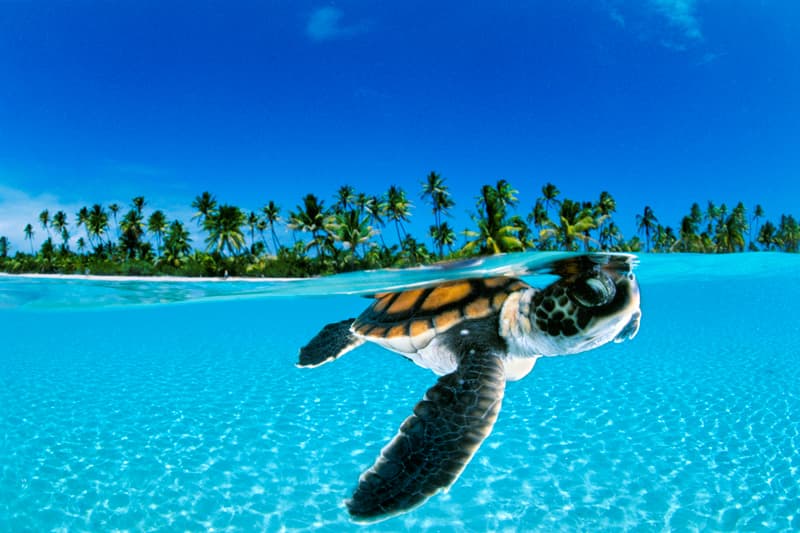Image: A baby green sea turtle swims for the safety of the open sea, French Polynesia © David Doubilet
In a career spanning more than 40 years, David Doubilet has extensively documented the world’s underwater ecosystems and become the most celebrated living underwater photographer. He has published 12 books, written almost 70 stories for National Geographic magazine and won numerous awards.
His work combines photographic expertise with a detailed knowledge of marine biology, capturing the wonder and strangeness of the underwater world. As he explained when I interviewed him in 2009, it’s this otherworldly quality that appeals to him most.
‘The sea covers most of our planet but visually it’s a far different world,’ he said. ‘It’s an extraordinarily beautiful, mysterious, delicate environment, where rules – even the rules of how you photograph things – are all changed. The aesthetics aren’t, but the rules are. It keeps you looking and looking and it becomes addictive.’
Doubilet’s early fascination with the sea led him to start snorkelling at the age of eight in a lake at a summer camp in the Adirondack region of New York state. By the age of 12 he was shooting underwater photographs with a Brownie Hawkeye camera. He kept it watertight in a rubber anaesthetist’s bag from the hospital at which his father worked.
It was an inventive approach with the materials available, but the results were not good. ‘The bag was filled with air and it was like trying to submerge the Hindenburg,’ Doubilet said. ‘The pictures were barely recognisable.’
He made his first sale, to a Brazilian magazine, at the age of 15, and was shooting professionally from his late teens. Around this time he won a competition with Mundo Submerso magazine, which brought him a $1,000 prize. A year after graduating from Boston University College of Communication, he got what he calls his ‘big break’ and shot his first story for National Geographic on garden eels in the Red Sea in Israel. He worked on this project with the renowned ichthyologist and authority on sharks, Dr Eugenie Clark, and went on to collaborate with her on a number of other assignments. It was also the beginning of his long association with National Geographic, one that he has maintained throughout his career.

Image: Barracuda encircling diver Dinah Halstead, photographed in the sea off Papua New Guinea © David Doubilet
Doubilet’s assignments have led him to photograph in a variety of marine and freshwater environments across the world, travelling to New Zealand, Canada, Antarctica, Japan, Tasmania, the northwest Atlantic and even the murky depths of Scotland’s Loch Ness. He has taken spectacular aerial shots, photographed a rich diversity of marine life and recorded a number of aeroplane and shipwrecks in their resting places on the seabed.
His determination to push technical boundaries in his work resulted in the invention of the first ‘split-level’ camera, which has different focus points for the top and bottom halves of the lens. It allows the photographer to shoot what’s over and under the water surface simultaneously, and Doubilet has used it to spectacular effect. One famous example is his shot of a baby green sea turtle in the clear blue waters off French Polynesia.
Doubilet’s work has always focused on celebrating the beauty of the underwater world rather than photographing the damage being done to it. ‘A photograph of a sewer pipe belching into the pristine water is a picture for the front page of a newspaper, rather than one that has any lasting value or that represents what really exists in the oceans,’ he said in an AP interview in 2002.
‘Our ethic to save whales, for example, has come from people taking pictures of whales,’ he added. ‘I think that if you show the jewel and say this is what we protect, this is what we fight for, it makes all wildlife photographers into very important journalists. They show what exists, they talk about the problems and they will affect the solution.’
 Image: David Doubilet, photographed by his partner Jennifer Hayes © Jennifer Hayes
Image: David Doubilet, photographed by his partner Jennifer Hayes © Jennifer Hayes
For many years, Doubilet has worked on assignments with his partner, Jennifer Hayes, who is also an aquatic biologist and photojournalist. For Doubilet, the most exciting times are those spent in the field, when he might spend up to nine hours a day in the water. During the period when they are not on assignment, they live in the small town of Clayton in New York state, and have a second home in De Kelders, South Africa.
Doubilet, now 65, is increasingly using his work to highlight the growing environmental threat to the world’s marine life, particularly from over-fishing and acidification caused by the ocean’s absorption of the excessive carbon dioxide in the atmosphere. His aim is to ‘create a visual voice for the world’s oceans and to connect people to the incredible beauty and silent devastation happening within the invisible world below.’
When asked in a recent interview if he could do one thing to save the ocean, he replied: ‘It would be to introduce every person on this planet to the important role the ocean has in their life, and make them aware that the ocean is truly the Earth’s engine.’
Books and websites
Books: Doubilet’s books include Water Light Time (1999), Great Barrier Reef (2002) and Fish Face (2003). His most recent book, Face to Face with Sharks (2009), is aimed at a younger audience.
Websites: Doubilet’s official website is www.daviddoubilet.com. To see a short ‘Conservation Conversation with Doubilet and Jennifer Hayes’, talking about their work, visit https://vimeo.com/39236062. There’s also a detailed 2011 interview with Doubilet on www.alertdiver.com/David_Doubilet.
Biography
- 1946: Born on 28 November in New York City, USA
- 1958: Begins taking underwater photographs using a Brownie Hawkeye camera in a rubber anaesthetist’s bag
- 1970: Graduates from Boston University College of Communication
- 1971: Shoots his first story for National Geographic magazine, on garden eels in the Red Sea
- 1999: Publication of Doubilet’s career retrospective book Water Light Time
- 2000: Made an honorary member of the Royal Photographic Society
- 2001: In recognition of his work, he wins the Lennart Nilsson Award for Scientific Photography
- 2001: Becomes a National Geographic contributing photographer-in-residence
- 2002: Inducted into the International Scuba Diving Hall of Fame
- 2005: Invited to become one of the founder members of the prestigious International League of Conservation Photographers







